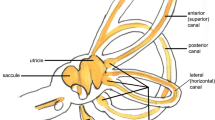Abstract
Benign paroxysmal positional vertigo (BPPV) is one of the most common peripheral vestibular diseases. The aim of this study was to explore the prevalence of BPPV in vertigo patients and the characteristics of BPPV in diagnosis and repositioning using mechanical assistance maneuvers and to analyze and summarize the reasons showing these characteristics. Seven hundred and twenty-six patients with vertigo were enrolled in this study. All patients were inspected by TRV armchair (SYNAPSYS, model TRV, France). BPPV patients were identified by the examination results. The characteristics and results using TRV armchair in diagnosis and treatment of BPPV were compared and analyzed. Of 726 vertigo patients, 209 BPPV patients were diagnosed, including 58 men and 151 women, aged from 16 to 87 (mean 52.90 ± 11.93) years. There were significant differences in the proportion of BPPV in male and female vertigo patients (P = 0.0233), but no differences among all age groups (P = 0.3201). Of 209 BPPV patients, 208 cases were repositioned by TRV armchair and no one appeared to have otolithic debris relocated into another canal in the repositioning procedures. 202 cases (97.12 %) were successful and six cases (2.87 %) were effective. None of them failed. This study suggests that BPPV is one of the most common diseases in the young vertigo patients, just like that in the old ones. Female of the species has predilection for BPPV and the site of predilection is the right posterior semicircular canals (PC-BPPV). The results of repositioning are perfect using mechanical assistance maneuvers.


Similar content being viewed by others
References
Beshkar M, Hasheminasab M, Mohammadi F (2013) Benign paroxysmal positional vertigo as a complication of orthognathic surgery. J Craniomaxillofac Surg 41:59–61
Lee SH, Kim JS (2010) Benign paroxysmal positional vertigo. J Clin Neurol 6:51–63
Honrubia V, Baloh RW, Harris MR et al (1999) Paroxysmal positional vertigo syndrome. Am J Otol 20:465–470
Baloh RW, Yue Q, Jacobson KM et al (1995) Persistent direction-changing positional nystagmus: another variant of benign positional nystagmus? Neurology 45:1297–1301
McClure JA (1985) Horizontal canal BPV. J Otolaryngol 14:30–35
Schratzenstaller B, Wagner-Manslau C, Strasser G et al (2005) Canalolithiasis of the superior semicircular canal: an anomaly in benign paroxysmal vertigo. Acta Otolaryngol 125:1055–1062
Humphriss RL, Baguley DM, Sparkes V et al (2003) Contraindications to the Dix–Hallpike manoeuvre: a multidisciplinary review. Int J Audiol 42:166–173
Dispenza F, Kulamarva G, De Stefano A (2012) Comparison of repositioning maneuvers for benign paroxysmal positional vertigo of posterior semicircular canal: advantages of hybrid maneuver. Am J Otolaryngol 33:528–532
Richard-Vitton T, Viirre E (2011) Unsteadiness and drunkenness sensations as a new sub-type of BPPV. Rev Laryngol Otol Rhinol (Bord) 132:75–80
Bertholon P, Tringali S, Faye MB et al (2006) Prospective study of positional nystagmus in 100 consecutive patients. Ann Otol Rhinol Laryngol 115:587–594
Schuknecht HF (1969) Cupulolithiasis. Arch Otolaryngol 90:765–778
Hall SF, Ruby RR, McClure JA (1979) The mechanics of benign paroxysmal vertigo. J Otolaryngol 8:151–158
Parnes LS, McClure JA (1992) Free-floating endolymph particles: a new operative finding during posterior semicircular canal occlusion. Laryngoscope 102:988–992
Semont A, Freyss G, Vitte E (1988) Curing the BPPV with a liberatory maneuver. Adv Otorhinolaryngol 42:290–293
Epley JM (1992) The canalith repositioning procedure: for treatment of benign paroxysmal positional vertigo. Otolaryngol Head Neck Surg 107:399–404
Riga M, Bibas A, Xenellis J et al (2011) Inner ear disease and benign paroxysmal positional vertigo: a critical review of incidence, clinical characteristics, and management. Int J Otolaryngol 2011:709469
Gordon CR, Levite R, Joffe V et al (2004) Is posttraumatic benign paroxysmal positional vertigo different from the idiopathic form? Arch Neurol 61:1590–1593
Karlberg M, Hall K, Quickert N et al (2000) What inner ear diseases cause benign paroxysmal positional vertigo? Acta Otolaryngol 120:380–385
Jeong SH, Choi SH, Kim JY et al (2009) Osteopenia and osteoporosis in idiopathic benign positional vertigo. Neurology 72:1069–1076
Acknowledgments
This research was supported by Grants from the National Natural Science Foundation of China (81200739) and the Science and Technology Committee of Shanghai Municipality (KF1204).
Author information
Authors and Affiliations
Corresponding author
Electronic supplementary material
Below is the link to the electronic supplementary material.
Video 1 Dix-Hallpike Test and Roll Test on TRV Armchair. There are three segments in this video chip. The first one is how to do Left Dix–Hallpike Test to make sure whether there are particles in left posterior semicircular canal and/or right superior semicircular canal. The second one is how to do Right Dix–Hallpike Test to make sure whether there are particles in right posterior semicircular canal and/or left superior semicircular canal. The third one is how to do Roll Test to make sure whether there are particles in right and/or left horizontal semicircular canal. (WMV 24115 kb)
Video 2 Dynamic Barbecue Maneuver on TRV Armchair to free cupulolithiasis of left horizontal semicircular canal. (MPEG 15882 kb)
Rights and permissions
About this article
Cite this article
Wang, J., Chi, Fl., Jia, Xh. et al. Does benign paroxysmal positional vertigo explain age and gender variation in patients with vertigo by mechanical assistance maneuvers?. Neurol Sci 35, 1731–1736 (2014). https://doi.org/10.1007/s10072-014-1822-5
Received:
Accepted:
Published:
Issue Date:
DOI: https://doi.org/10.1007/s10072-014-1822-5




